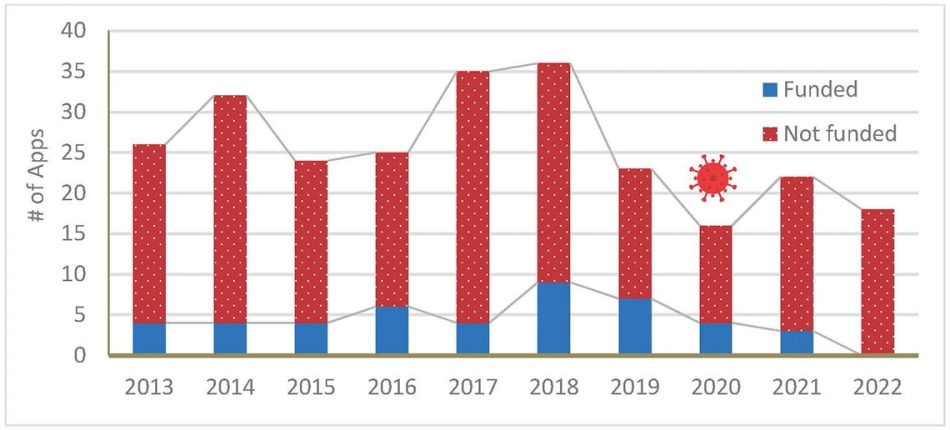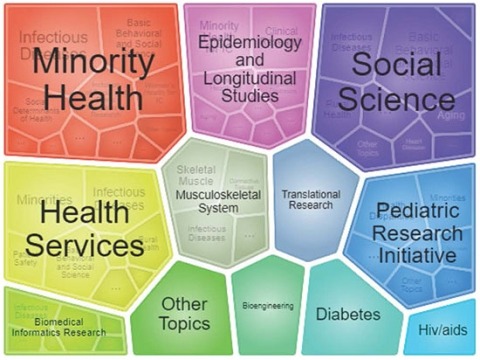Reissuance of NIDCR Small Research Grants for Oral Health Data Analysis and Statistical Methodology Development (R03 Clinical Trial Not Allowed)
January 2022
Division of Extramural Research
Back to topGoal
The NIDCR clinical research programs support a broad portfolio of studies, including clinical trials, technology development studies and large-scale epidemiologic research projects. The resultant wealth of data generated by these studies often provides unique opportunities that could be leveraged to investigate additional research questions or develop and test new analytical approaches. These and other dental, oral, and craniofacial health data may also be integrated with and enriched by other existing data sources (e.g., electronic medical records, pharmacy, medical claims data, emergency services, personal health and wellness measurements, socio-ecologic or economic data, ancillary studies, additional laboratory data, state registries, veteran’s administration data, etc.).
The goal of this Concept is to provide investigators with the support necessary to conduct such secondary data analyses or develop statistical methods for analyzing oral health data utilizing existing database resources.
Back to topBackground
This funding opportunity announcement (FOA) supports research that utilizes the R03 small grant mechanism, and it is limited in time (up to 2 years) and amount (up to $100,000 direct costs per year). The first version of this FOA was published in 2004, and since then it has been consistently utilized by junior and senior investigators to address diverse issues related to dental, oral, and craniofacial health.
There has been a steady number of new, competing applications received over the years. The figure below shows the number of submitted and awarded applications by Fiscal Year for the past 10 years (with the most recent data still in progress). Fewer applications were received in 2020 probably due to the COVID-19 pandemic that disrupted research for many investigators.
Investigators funded through this opportunity have been very productive. Approximately 80% of the awards have resulted in one or more publications. A portfolio analysis of the past 10 years shows a total of 135 publications and 1,070 related citations, with a mean relative citation ratio RCR of 1.55. The RCR measures the scientific influence of each paper by field-and time-adjusting the citations it has received, and benchmarking to the median for NIH publications, the value of which is set at 1.0.
The currently active FOA was first published on January 8, 2019 and it is due to expire on May 8, 2022. Since 2019, 66 applications (59 competing) have been received, and 11 (7 competing) have been awarded (12% success rate for new applications). Of the 9 principal investigators receiving 7 new awards, 78% were females and 22% were non-underrepresented minorities. Almost half of the awards were led by dentist-scientists (43%), or new and early-stage investigators (43%).
Back to topGaps and Opportunities
This FOA continues to attract both junior and senior investigators, as well as dentist-scientists. Awardees have been productive through this mechanism. The research supported by this FOA has capitalized on existing data sources, including large NIDCR-funded repositories and longitudinal databases, to advance dental, oral, and craniofacial health knowledge. The FOA has also supported impactful research addressing methodological issues relevant to the analysis and interpretation of oral, dental, and craniofacial findings.
The reissuance offers an opportunity to include additional high-quality datasets for analysis that captured fields reflecting state-of-the-science, and to further encourage the analyses of integrated databases that capture information from the craniofacial complex, while considering its links to overall physical and mental health, and the socio-ecological structure.
Back to topSpecific Areas of Interest
The FOA has a dual focus: analyses of existing dental, oral, and craniofacial data and new methods development, and the supported research is not restricted to a specific craniofacial disease or condition. Many of the awarded projects have utilized large or population-based longitudinal data and/or multicenter data.
Research projects supported by these FOAs have analyzed and produced publications on various, relevant dental, oral and craniofacial health topics and methods, including diabetes and oral health using EHRs, childhood dental caries, fluoride/fluorosis, craniofacial microsomia, oral health disparities, pediatric preventive dental services, network meta-analysis to aid decision making, statins and oral health, orofacial cleft repair, and other topics and methods.
The most recent applications have included research studies of TMJ imaging methodology, periodontal treatment, access to dental care, Sjögren’s syndrome, epigenetics, enamel developmental defects, quality assessment of oral data repositories.
Back to topReferences
- PAR-19-145: NIDCR Small Research Grants for Oral Health Data Analysis and Statistical Methodology Development (R03 Clinical Trial Not Allowed)
- NOT-DE-21-017: Notice to Extend Expiration Date for PAR-19-145 "NIDCR Small Research Grants for Oral Health Data Analysis and Statistical Methodology Development (R03)
- https://journals.plos.org/plosbiology/article?id=10.1371/journal.pbio.1002541
Historic FOAs
- PAR-15-344: NIDCR Small Research Grants for Oral Health Data Analysis and Statistical Methodology Development (R03)
- PAR-12-120: NIDCR Small Research Grants for Oral Health Data Analysis and Statistical Methodology Development (R03)
- PAR-09-182: NIDCR Small Research Grants for Data Analysis and Statistical Methodology (R03)
- PAR-06-211: NIDCR Small Research Grants for Data Analysis and Statistical Methodology (R03)
- PAR-04-091: NIDCR Small Research Grants for Data Analysis and Statistical Methodology (R03)
Examples of Recent Publications
- Lipton BJ, Finlayson TL, Decker SL, Manski RJ, Yang M. The Association Between Medicaid Adult Dental Coverage and Children's Oral Health. Health Aff (Millwood). 2021 Nov;40(11):1731-1739. doi: 10.1377/hlthaff.2021.01135. PMID: 34724426; PMCID: PMC8609949.
- da Costa Rosa T, de Almeida Neves A, Azcarate-Peril MA, Divaris K, Wu D, Cho H, Moss K, Paster BJ, Chen T, B Freitas-Fernandes L, Fidalgo TKS, Tadeu Lopes R, Valente AP, R Arnold R, de Aguiar Ribeiro A. The bacterial microbiome and metabolome in caries progression and arrest. J Oral Microbiol. 2021 Jun 16;13(1):1886748. doi: 10.1080/20002297.2021.1886748. PMID: 34188775; PMCID: PMC8211139.
- Okunseri CE, Okunseri E, Garcia RI, Visotcky A, Szabo A. Geographic variations in dental sealant utilization by Medicaid enrollees. J Public Health Dent. 2021 Jun;81(2):123-130. doi: 10.1111/jphd.12420. Epub 2020 Nov 11. PMID: 33174220.
- Luo H, Wu Q, Bell RA, Wright W, Quandt SA, Basu R, Moss ME. Rural-Urban Differences in Dental Service Utilization and Dental Service Procedures Received Among US Adults: Results From the 2016 Medical Expenditure Panel Survey. J Rural Health. 2021 Jun;37(3):655-666. doi: 10.1111/jrh.12500. Epub 2020 Jul 22. PMID: 32697007; PMCID: PMC7855605.
- Kang T, Levy SM, Datta S. Analyzing longitudinal clustered count data with zero inflation: Marginal modeling using the Conway-Maxwell-Poisson distribution. Biom J. 2021 Apr;63(4):761-786. doi: 10.1002/bimj.202000061. Epub 2021 Jan 4. PMID: 33393147.
- Kang T, Gaskins J, Levy S, Datta S. A longitudinal Bayesian mixed effects model with hurdle Conway-Maxwell-Poisson distribution. Stat Med. 2021 Mar 15;40(6):1336-1356. doi: 10.1002/sim.8844. Epub 2020 Dec 23. PMID: 33368533.
- Wu D, Li C. Joint analysis of multivariate interval-censored survival data and a time-dependent covariate. Stat Methods Med Res. 2021 Mar;30(3):769-784. doi: 10.1177/0962280220975064. Epub 2020 Dec 1. PMID: 33256555.
- Duncan WD, Thyvalikakath T, Haendel M, Torniai C, Hernandez P, Song M, Acharya A, Caplan DJ, Schleyer T, Ruttenberg A. Structuring, reuse and analysis of electronic dental data using the Oral Health and Disease Ontology. J Biomed Semantics. 2020 Aug 20;11(1):8. doi: 10.1186/s13326-020-00222-0. PMID: 32819435; PMCID: PMC7439527.
December 2024


